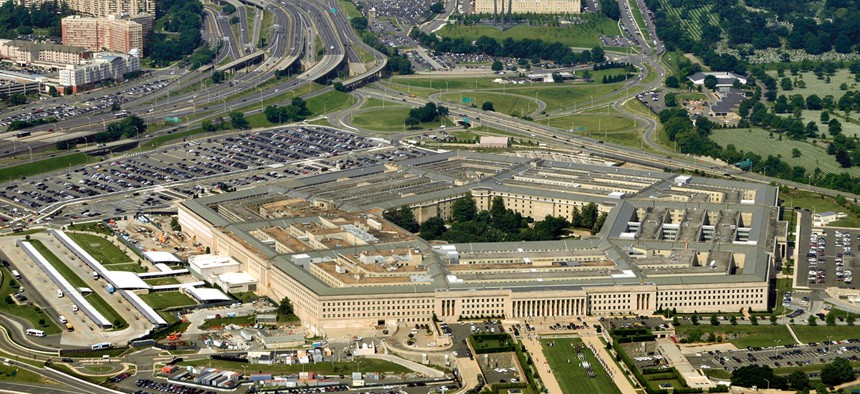How the Digital Transformation Will Upend the Pentagon

Frontpage/Shutterstock.com
DOD is one of the most complex and widespread organizations in the world, but in today’s battlespace, embracing digitization helps pull together all aspects of defense.
Nick Michaelides is a U.S. federal leader at Cisco.
Take a look around and you’ll see it affecting everything. What is it? Digitization.
Drones flying overhead, providing new perspectives and creating new video data. Smart vehicles parking themselves and autonomous cars cruising the highways without drivers. Wearables recording exercise and calories to improve activity level and health. Messaging and video conferencing tools connecting individuals and boardrooms instantly despite being oceans apart. Students in classrooms, coffee shops and living rooms sharing notes and working on assignments in a collaborative, online environment.
All of these are examples of the power of digitization: bringing people, processes, data and things together to create fully connected environments to improve and simplify information sharing, collaboration, operations and decision-making.
Generating these outcomes is important for meeting the needs of any business or government organization, but there are few places where it is more critical than in the battle space.
The Defense Department is one of the most complex and widespread organizations in the world, but in today’s battle space, embracing digitization helps pull together all aspects of defense. Through the latest technologies and solutions, digitization enables joint operations on the battlefield and facilitates real-time, reliable information sharing required to connect military leaders with bases around the world and deployed soldiers, sailors, airmen and Marines operating in the field.
In the battle space, decisions and logistics are aimed at supporting field operations, which includes deployed troops, information gathering through drones or other intelligence, surveillance and reconnaissance assets and vehicle support. Digitization puts the secure mission fabric on a digital platform and enables it to stretch from the data center to the tactical edge.
Transforming data into real-time information is essential to mission success. For example, geospatial mapping of terrain is critical for soldiers operating in unfamiliar surroundings. Through remote sensors and ISR assets, military personnel can gather and save valuable information in the data center.
This information can be further transformed through analytics to generate critical insights. These insights can be taken from the data center and shared with soldiers in real-time as they traverse new areas. The entire process of transformation from data to information, information to knowledge, and knowledge to wisdom improves real-time decision-making and impacts long term strategic planning.
It seems simple, but enabling these types of secure network connections, from ISR assets to the data center and back out to the soldiers at the edge, is complex and critical to producing positive mission outcomes.
One of the key challenges DOD and other federal agencies face is updating aging IT infrastructure. To enhance battle space operations, the military must upgrade and modernize its IT environments to have the network capabilities needed today and the flexibility to easily adapt for tomorrow.
This is precisely why many DOD IT leaders are asking themselves whether their current infrastructure truly supports the operational level they want to get to. Ensuring digital network readiness is something that’s important across DOD and civilian agencies, as well as other public and private sector organizations.
As this digital transformation continues, cybersecurity is probably the biggest concern for military leaders. The Navy just recently issued a proposal seeking $88 million in cyber R&D funding, a clear indicator of cybersecurity’s importance to Navy operations.
Federal agencies overall are priority targets for cyberattackers, but DOD is especially attractive for nation-state and other malicious actors seeking access to sensitive data and intelligence. Last year, the Joint Chiefs of Staff had its Pentagon email hacked by a sophisticated attack.
Whether it’s to steal or manipulate data, advanced threats are attempting to infiltrate DOD networks through whatever channels prove effective. It could be through physical security cameras, HVAC systems or one of the many new devices connecting to the network at the edge as part of the continued growth of the Internet of Things. This is why agencies must take a pervasive, end-to-end approach to integrate cybersecurity across military environments.
DOD is a clear leader from an IoT perspective. Remote sensors, mobile computing devices in backpacks and other operational technologies are being deployed to support mission readiness and effectiveness. But the key to maximizing IoT assets is taking the data captured at the edge, processing it, using it in real time and then transferring it to a secure cloud environment, as well as back to secure data centers as quickly as possible.
For military leaders, the objective is simple. Utilize the connections and data collected from IoT devices and transform it into real, actionable intelligence to help achieve the mission. However, this process, including the ability to perform real-time analysis at the edge, isn’t possible without a modern IT infrastructure and powerful network.
DOD is already seeing the power of digitization in operations across the battlespace today – from monitoring soldiers’ vital signs with wearable sensors to securely sending ISR data back to data centers, or using secure video to connect remote bases and share intelligence.
Digital transformation is about utilizing the latest technologies and generating positive operational and business outcomes. DOD is just beginning to unlock digitization’s value in the battlespace and it is exciting to think about where things will go from here.



 By
By